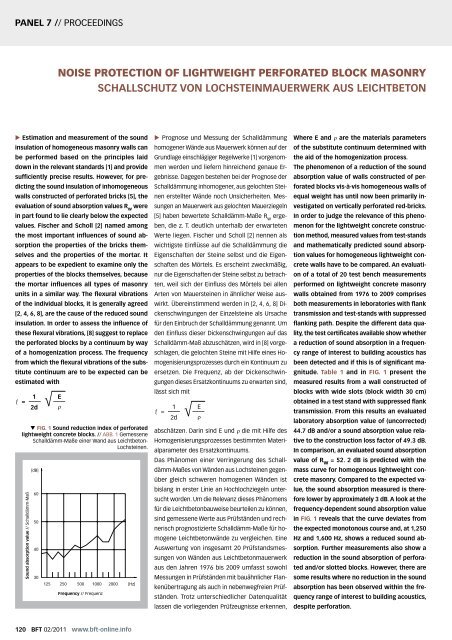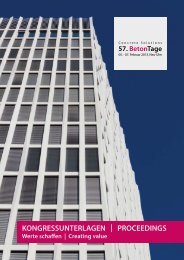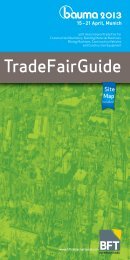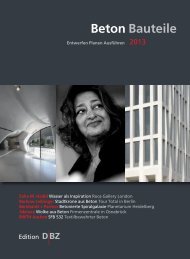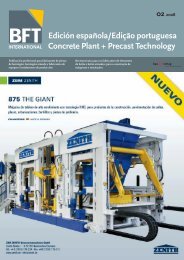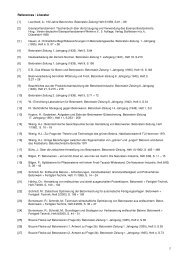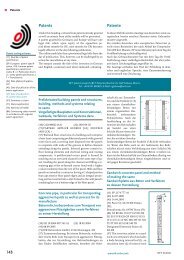Tagungsband - BFT International
Tagungsband - BFT International
Tagungsband - BFT International
Sie wollen auch ein ePaper? Erhöhen Sie die Reichweite Ihrer Titel.
YUMPU macht aus Druck-PDFs automatisch weboptimierte ePaper, die Google liebt.
PANEL 7 // PROCEEDINGS<br />
� Estimation and measurement of the sound<br />
insulation of homogeneous masonry walls can<br />
be performed based on the principles laid<br />
down in the relevant standards [1] and provide<br />
sufficiently precise results. However, for pre-<br />
dicting the sound insulation of inhomogeneous<br />
walls constructed of perforated bricks [5], the<br />
evaluation of sound absorption values R w were<br />
in part found to lie clearly below the expected<br />
values. Fischer and Scholl [2] named among<br />
the most important influences of sound ab-<br />
sorption the properties of the bricks them-<br />
selves and the properties of the mortar. It<br />
appears to be expedient to examine only the<br />
properties of the blocks themselves, because<br />
the mortar influences all types of masonry<br />
units in a similar way. The flexural vibrations<br />
of the individual blocks, it is generally agreed<br />
[2, 4, 6, 8], are the cause of the reduced sound<br />
insulation. In order to assess the influence of<br />
these flexural vibrations, [8] suggest to replace<br />
the perforated blocks by a continuum by way<br />
of a homogenization process. The frequency<br />
from which the flexural vibrations of the subs-<br />
titute continuum are to be expected can be<br />
estimated with<br />
NOISE PROTECTION OF LIGHTWEIGHT PERFORATED BLOCK MASONRY<br />
SCHALLSCHUTZ VON LOCHSTEINMAUERWERK AUS LEICHTBETON<br />
lässt sich mit<br />
1 E<br />
ƒ = –––– √ ––––<br />
2d ρ<br />
1 E<br />
ƒ = –––– √––––<br />
2d ρ<br />
� FIG. 1 Sound reduction index of perforated<br />
lightweight concrete blocks. // ABB. 1 Gemessene<br />
Schalldämm-Maße einer Wand aus Leichtbeton-<br />
Lochsteinen.<br />
Sound absorption value // Schalldämm-Maß<br />
[dB]<br />
60<br />
50<br />
40<br />
30<br />
125 250 500 1000 2000 [Hz]<br />
Frequency // Frequenz<br />
120 <strong>BFT</strong> 02/2011 www.bft-online.info<br />
� Prognose und Messung der Schalldämmung<br />
homogener Wände aus Mauerwerk können auf der<br />
Grundlage einschlägiger Regelwerke [1] vorgenom-<br />
men werden und liefern hinreichend genaue Er-<br />
gebnisse. Dagegen bestehen bei der Prognose der<br />
Schalldämmung inhomogener, aus gelochten Stei-<br />
nen erstellter Wände noch Unsicherheiten. Mes-<br />
sungen an Mauerwerk aus gelochten Mauerziegeln<br />
[5] haben bewertete Schalldämm-Maße R w erge-<br />
ben, die z. T. deutlich unterhalb der erwarteten<br />
Werte liegen. Fischer und Scholl [2] nennen als<br />
wichtigste Einflüsse auf die Schalldämmung die<br />
Eigenschaften der Steine selbst und die Eigen-<br />
schaften des Mörtels. Es erscheint zweckmäßig,<br />
nur die Eigenschaften der Steine selbst zu betrach-<br />
ten, weil sich der Einfluss des Mörtels bei allen<br />
Arten von Mauersteinen in ähnlicher Weise aus-<br />
wirkt. Übereinstimmend werden in [2, 4, 6, 8] Di-<br />
ckenschwingungen der Einzelsteine als Ursache<br />
für den Einbruch der Schalldämmung genannt. Um<br />
den Einfluss dieser Dickenschwingungen auf das<br />
Schalldämm-Maß abzuschätzen, wird in [8] vorge-<br />
schlagen, die gelochten Steine mit Hilfe eines Ho-<br />
mogenisierungsprozesses durch ein Kontinuum zu<br />
ersetzen. Die Frequenz, ab der Dickenschwin-<br />
gungen dieses Ersatzkontinuums zu erwarten sind,<br />
abschätzen. Darin sind E und ρ die mit Hilfe des<br />
Homogenisierungsprozesses bestimmten Materi-<br />
alparameter des Ersatzkontinuums.<br />
Das Phänomen einer Verringerung des Schall-<br />
dämm-Maßes von Wänden aus Lochsteinen gegen-<br />
über gleich schweren homogenen Wänden ist<br />
bislang in erster Linie an Hochlochziegeln unter-<br />
sucht worden. Um die Relevanz dieses Phänomens<br />
für die Leichtbetonbauweise beurteilen zu können,<br />
sind gemessene Werte aus Prüfständen und rech-<br />
nerisch prognostizierte Schalldämm-Maße für ho-<br />
mogene Leichtbetonwände zu vergleichen. Eine<br />
Auswertung von insgesamt 20 Prüfstandsmes-<br />
sungen von Wänden aus Leichtbetonmauerwerk<br />
aus den Jahren 1976 bis 2009 umfasst sowohl<br />
Messungen in Prüfständen mit bauähnlicher Flan-<br />
kenübertragung als auch in nebenwegfreien Prüf-<br />
ständen. Trotz unterschiedlicher Datenqualität<br />
lassen die vorliegenden Prüfzeugnisse erkennen,<br />
Where E and ρ are the materials parameters<br />
of the substitute continuum determined with<br />
the aid of the homogenization process.<br />
The phenomenon of a reduction of the sound<br />
absorption value of walls constructed of per-<br />
forated blocks vis-à-vis homogeneous walls of<br />
equal weight has until now been primarily in-<br />
vestigated on vertically perforated red-bricks.<br />
In order to judge the relevance of this pheno-<br />
menon for the lightweight concrete construc-<br />
tion method, measured values from test-stands<br />
and mathematically predicted sound absorp-<br />
tion values for homogeneous lightweight con-<br />
crete walls have to be compared. An evaluati-<br />
on of a total of 20 test bench measurements<br />
performed on lightweight concrete masonry<br />
walls obtained from 1976 to 2009 comprises<br />
both measurements in leboratories with flank<br />
transmission and test-stands with suppressed<br />
flanking path. Despite the different data qua-<br />
lity, the test certificates available show whether<br />
a reduction of sound absorption in a frequen-<br />
cy range of interest to building acoustics has<br />
been detected and if this is of significant ma-<br />
gnitude. Table 1 and in FIG. 1 present the<br />
measured results from a wall constructed of<br />
blocks with wide slots (block width 30 cm)<br />
obtained in a test stand with suppressed flank<br />
transmission. From this results an evaluated<br />
laboratory absorption value of (uncorrected)<br />
44.7 dB and/or a sound absorption value rela-<br />
tive to the construction loss factor of 49.3 dB.<br />
In comparison, an evaluated sound absorption<br />
value of R w = 52. 2 dB is predicted with the<br />
mass curve for homogenous lightweight con-<br />
crete masonry. Compared to the expected va-<br />
lue, the sound absorption measured is there-<br />
fore lower by approximately 3 dB. A look at the<br />
frequency-dependent sound absorption value<br />
in FIG. 1 reveals that the curve deviates from<br />
the expected monotonous course and, at 1,250<br />
Hz and 1,600 Hz, shows a reduced sound ab-<br />
sorption. Further measurements also show a<br />
reduction in the sound absorption of perfora-<br />
ted and/or slotted blocks. However, there are<br />
some results where no reduction in the sound<br />
absorption has been observed within the fre-<br />
quency range of interest to building acoustics,<br />
despite perforation.


